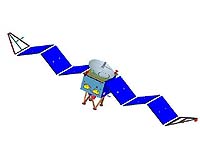 |
for Astrobiology Magazine Moffett Field CA (SPX) Nov 18, 2010 Since the arrival to the McMurdo station in the Antarctic two days ago, most of our time has been spent on assembling and testing our Mars prototype drill: the Icebreaker. Icebreaker was built to break into the hard icy soil of Mars. On our first day at the McMurdo station we went to our laboratory and found that only two out of the eight boxes we shipped to Antarctic two months ago actually made it here. We were worried that the remaining six boxes may still be in New Zealand, or even worse in the US! However, while walking to the Science Cargo building, we found all of our remaining boxes among other shipped items, lying on the frozen ground and waiting for their owners. We were ecstatic. The following day, the McMurdo crew moved our boxes into the warm laboratory where we could put together the drill and test it. At this time, all boxes are unpacked and every part that makes up the drill has been inspected. We carefully looked at our rotary-percussive drill head that rotates the drill bit and also generates percussive or hammering action (similar to a hardware store drill). We wanted to make sure that all the internal mechanisms such as motors, gears, and bearings survived the trip to Antarctica. The drill head is quite complicated since it has to work in the extreme cold of Antarctic, and the combined extreme cold plus vacuum environment on Mars. We also inspected our Z-stage, that lowers the drill one meter down into the subsurface, and an auger bit - a slender one meter long rod that looks likes a screw with deep threads and a bit at the end. The bit has a small thermocouple that measures the bit's temperature and in turn tells us how much the surrounding soil heats up during drilling. After all, we don't want to accidentally melt the ice during drilling, and then freeze the drill in as the drilling stops and everything cools down very quickly. The temperature sensor and all other drill parts looked fine. It took us almost a day to assemble all the parts into a fully functional drill. We did a system level check (rotated the drill, moved the drill up/down, measured the bit temperature) to make sure everything works as planned. We also set up a teleoperation routine. We used a laptop connected to the Internet in another room, to operate a drill in an adjacent room. We will use the same routine next week, however, next week all the drill commands will be sent not from an adjacent room but from a school in San Francisco and through a satellite! A group of students will be able to drill a hole in the Antarctic permafrost thousands of miles away. We will also have Skype so they can see whether indeed the drill penetrates the ground.
Share This Article With Planet Earth
Related Links - Mars News and Information at MarsDaily.com Lunar Dreams and more
 2013 Earliest Launch Date For China Mars Mission
2013 Earliest Launch Date For China Mars MissionBeijing (XNA) Oct 25, 2010 China has drawn up a technical plan for an independent Mars orbiter exploration project, according to China's space technology expert. The plan was based on research conducted by the China Academy of Space Technology (CAST), said an expert Thursday here at a forum on China's space technology. The project will make use of technologies developed for China's first lunar satellite launch ... read more |
|
| The content herein, unless otherwise known to be public domain, are Copyright 1995-2010 - SpaceDaily. AFP and UPI Wire Stories are copyright Agence France-Presse and United Press International. ESA Portal Reports are copyright European Space Agency. All NASA sourced material is public domain. Additional copyrights may apply in whole or part to other bona fide parties. Advertising does not imply endorsement,agreement or approval of any opinions, statements or information provided by SpaceDaily on any Web page published or hosted by SpaceDaily. Privacy Statement |